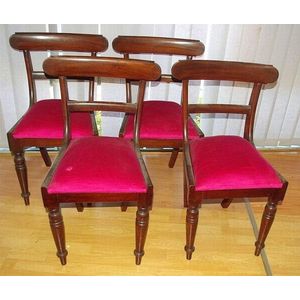Regency Klismos Armchairs with Suede Upholstery
Pair of Regency style Klismos armchairs, each with a curved tablet back centred by a flowerhead flanked by anthemion, with taupe suede upholstered seat, on sabre legs (2), height 85 cm, width 57 cm, depth 52 cm. provenance: The Estate of Martyn Cook, Sydney
You must be a subscriber, and be logged in to view price and dealer details.
Subscribe Now to view actual auction price for this item
When you subscribe, you have the option of setting the currency in which to display prices to $Au, $US, $NZ or Stg.
This item has been sold, and the description, image and price are for reference purposes only.
- Klismos Chair - The Klismos chair was originally developed by the ancient Greeks in the 5th century BC. The design with a rectangular curved back and concave tapeing legs was revived during the Regency period. Versions were made for the Earl of Harewood for the refurbished Entrance Hall at Harewood House, c. 1805.
- Provenance - A term used to describe the provable history of an antique or work of art, and thus an additional aid to verifying its authenticity. Provenance can have an inflating effect on the price of an item, particularly if the provenance relates to the early settlement of Australia, a famous person, or royalty. Less significant are previous sales of the item through an auction house or dealer.
- Anthemion - An anthemion is a classical decorative design element based on the acanthus flower that consists of a central circular or oval motif surrounded by radiating petals or leaves. It is often used as a border or frieze in architecture, furniture, and other decorative arts. The anthemion is derived from the palmette, a motif that was popular in ancient Greek and Roman art and architecture. It is often associated with the classical world and with Neoclassical style, and it is often used to add a sense of grandeur and formality to a design. The anthemion is also known as a honeysuckle or honeysuckle ornament. It continues to be used in a variety of contexts today, and it is often admired for its elegant and decorative qualities.
- Sabre Leg - The sabre leg is commonly associated with chairs made in the Regency or classical revival manner of the early 19th century. The form was copied from designs of the ancient Grecian chair known as a klismos found on painted classical vases. The characteristic of the sabre leg is a wide, sweeping backward curve which was frequently reeded, similar to a sabre. The sweep of the front legs was sometimes complemented by a corresponding curve in the back legs of the chair, though on most domestic furniture the sweep of the rear support was not as pronounced. Sabre legs are often encountered in reproductions of the regency style. They are uncommon in Australian furniture where, by and large, colonial craftsmen preferred to use turned legs.
- Regency Period - The Regency period in English furniture design refers to the period when King George III, was declared unfit to rule in 1811, and his son ruled as proxy as Prince Regent, until 1820, and then, after the death of his father as George IV until his death in 1830. The Regency period was preceded by the Georgian period (George I, George II, and George III: 1714 - 1811), and was followed by the William IV period, which only lasted until 1837 when William IV died as was succeeded by Queen Victoria.
This item has been included into following indexes:
-
chairs, singles / pairs / threes, style or period
- armchairs 1,732
- Klismos style 7
- Regency 234
Visually similar items

Set of four antique cedar rail back chairs
Sold by
in
for
You can display prices in $Au, $US, $NZ or Stg.

A painted Louis XVI style side chair, cameo backed in pink velvet upholstery, height 78 cm
Sold by
in
for
You can display prices in $Au, $US, $NZ or Stg.

A pair of late 19th century Chippendale style quality dining chairs, fancy pierced backs, the curved seats with silk type patterned upholstery
Sold by
in
for
You can display prices in $Au, $US, $NZ or Stg.

A pair of continental oak and red upholstered Renaissance style hall chairs. 106 cm high, 75 cm wide.
Sold by
in
for
You can display prices in $Au, $US, $NZ or Stg.
